[ad_1]
Marketing playbooks help you consistently produce campaigns and content in the face of continuous disruption. No matter which players are in the game (copywriters, designers, etc.), your playbook will help produce a consistent outcome.
The trouble is, most successful businesses like to keep their marketing playbooks close to their chests (for obvious reasons). This makes it difficult for new businesses, or those experimenting with new strategies, to learn best practices.
CXL likes to play by an entirely different set of rules, so they’ve created a marketing playbook community where experts can weigh in and share their experiences.
In short, CXL put winning marketing playbooks on the table for everyone to see.
In this article, you’ll learn how to create an impactful marketing playbook to show up consistently and grow your business.
Marketing playbooks are frameworks for consistent campaigns
A marketing playbook is a resource guide that dictates how a business approaches its marketing.
It’s the marketing equivalent to a coach’s playbook that covers definitions, formations, and tactics to bring players up to speed on how the team works so that they can execute a play correctly. In marketing’s case, the play is a campaign or channel.
For example, you might have a playbook for a brand awareness campaign that includes several channels. Or, you might have a playbook focused specifically on your Instagram content strategy.
By giving team members a repeatable (but flexible) framework to follow, outcomes are more consistent and teams work more efficiently, regardless of the individual members.
Consistency isn’t just a buzzword here. Marketing consistently earns trust, solidifies brand status, and improves customer experience, and it’s shown to add up to 20% to overall growth.
A consistent team is also an organized team, positively impacting performance. According to CoShedule’s 2022 Trend Report, organized marketers are 674% more likely to report success, and those that proactively plan (something you can easily do with a playbook) are 3x more likely to report success.
What makes a successful marketing playbook?
Every playbook differs depending on the end goal. But the purpose should always be the same: give marketers the knowledge to help them execute the plan effectively.
Achieving this helps:
- Create seamless, repeatable workflows;
- Cut down on wasted resources;
- Get marketing team members on the same page;
- Improve long-term customer marketing.
A playbook should cover the five main areas detailed in our guide to creating a marketing playbook for consistent campaigns:
- Strategy. A detailed marketing strategy isn’t required every time (e.g., if your playbook is on creating engaging Twitter threads, you can probably jump right to content creation). But you should always cover how the play ties to objectives, ideal customer profiles, and messaging.
- Content creation. Explain the type of content assets (including templates), brand guidelines, and roles and responsibilities of each team member.
- Promotional channels. Map out where content will be shared, how, and how often, including distribution roadmaps and any automation apps.
- Measurement. Show how teams will track the success of each campaign, channel, or asset, including KPIs and goal-related metrics and the tools used to measure performance. This is important to improving your playbooks and future campaigns.
- Execution. Map out the content creation timeline and any key milestones for goals and performance reviews. Here is where you should also cover the dos and don’ts of each platform.
While that seems like a lot of ground to cover, don’t get too bogged down in the details. A playbook isn’t designed to tell a marketer how to be a marketer, nor is it a company handbook. It’s there to guide your team towards a goal.
In the NBA, for example, a coach has a 75-second timeout to communicate a play well enough so each player knows what needs to happen and their role in achieving it.
To help you communicate your message as quickly and clearly as possible, let’s look at some marketing playbook examples from the CXL playbook community.
1. Playbooks are a team effort
Successful digital marketing doesn’t happen in an echo chamber. It takes a team of people bringing their know-how to the table.
For example, an idea that comes from a marketing manager is brought to life by a copywriter and designer, finely tuned by an editor, and shared by a social media executive. Each team member plays a critical role in a campaign having the desired impact.
CXL puts the community at the forefront of every playbook. Subject experts can comment and suggest improvements for each part.
Take this marketing playbook example on defining buyer personas:
It outlines four steps to define buyer personas, including tips and reminders in dropdown sections.
Below the key steps is an ongoing conversation about what to include and what these additions mean:
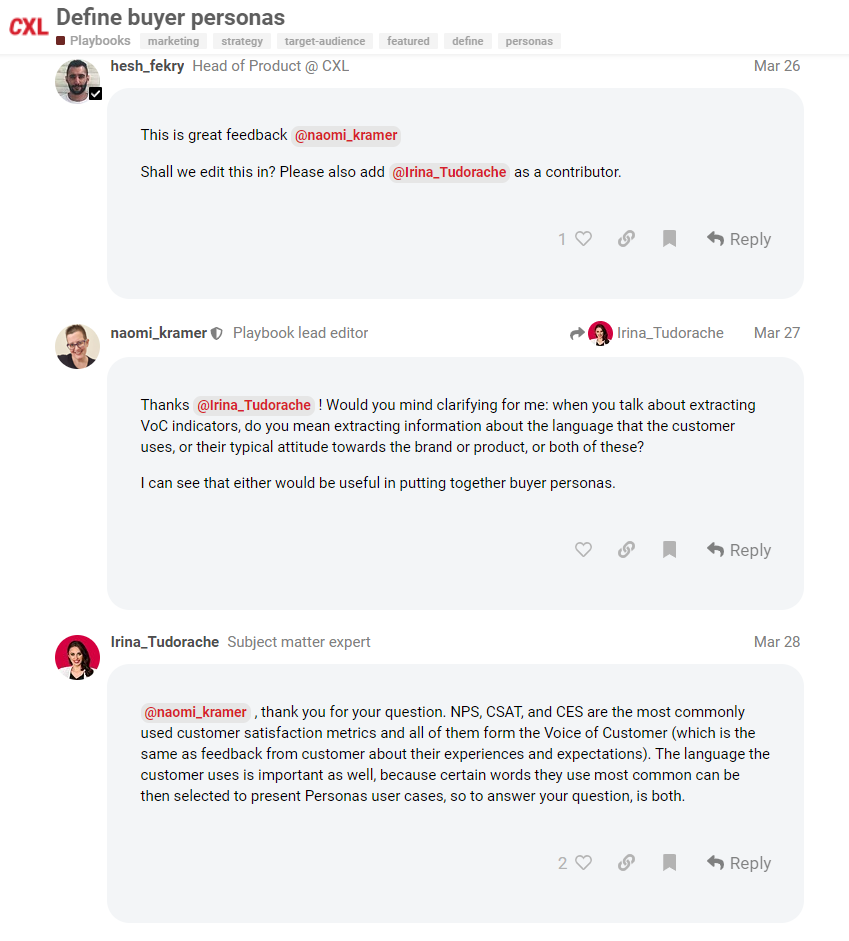
This active collaboration means that playbooks have the right information. It also ensures they stay relevant. If new research, tools, or changes in platform policies warrant a change in tactic, users can openly discuss the best ways to move forward.
Marketing goalposts are always moving. For example, who could have predicted at the start of 2020 that a global pandemic would force live events to move online?
Include every team that helps execute a campaign in creating your playbooks, and periodically review its contents.
Tapping into your people’s knowledge opens your eyes to blind spots and drives innovation. It also improves company culture and a campaign’s adoption. People will feel more involved in the process if their input is needed, making them more invested in its success.
This contribution may seem small, but it’s a critical move according to leaders. Some two-thirds of C-suite executives say that company culture is more important to performance than strategy or operating model.
The takeaway: When creating your marketing playbook, involve your team members.
2. Make goals and benefits clear
What is your playbook for? That’s the question you’ll want to answer from the start.
Playbooks are designed to save marketers time and help them work more efficiently. Having to dig through information to find out if a playbook matches their needs stops them from doing this.
Put your main goal front and center. CXL’s playbooks do it in the title:
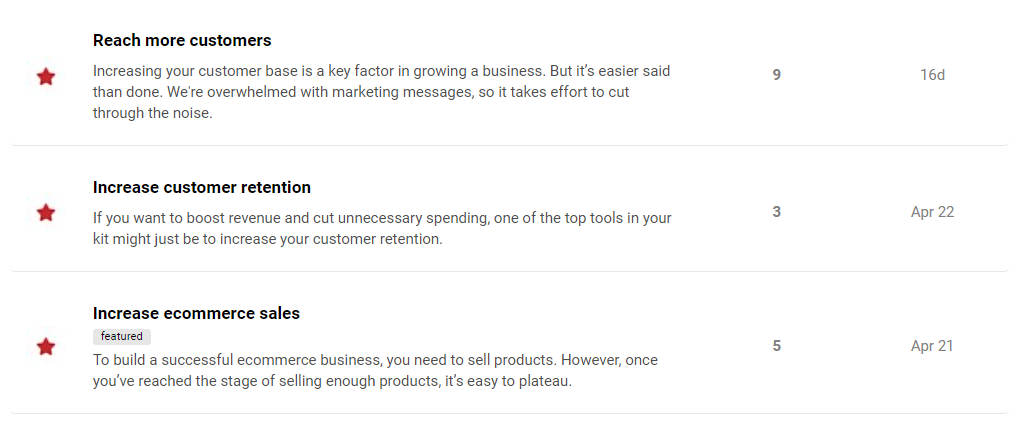
This gives instant clarity. Marketers know the problem the playbook is solving. The next question you need to answer is why the playbook exists: what are the benefits?
CXL playbooks lead with the benefit:

The goal in this playbook is to “segment your customer base.” The benefit is to “create personalized communications, better reach customer needs, and improve customer retention.”
The what and the why are communicated in two lines. There’s no need to get any deeper than that. Remember, a content marketing playbook is based on need-to-know information only.
That’s not to say everything should be limited to a single-sentence explanation. If your playbook includes a vague or confusing term, it’s better to offer a clear definition.
This will ensure that:
a) Everyone understands the information; and
b) Everyone’s working with the same definition.
Take CXL’s playbook on reducing bounce rate:
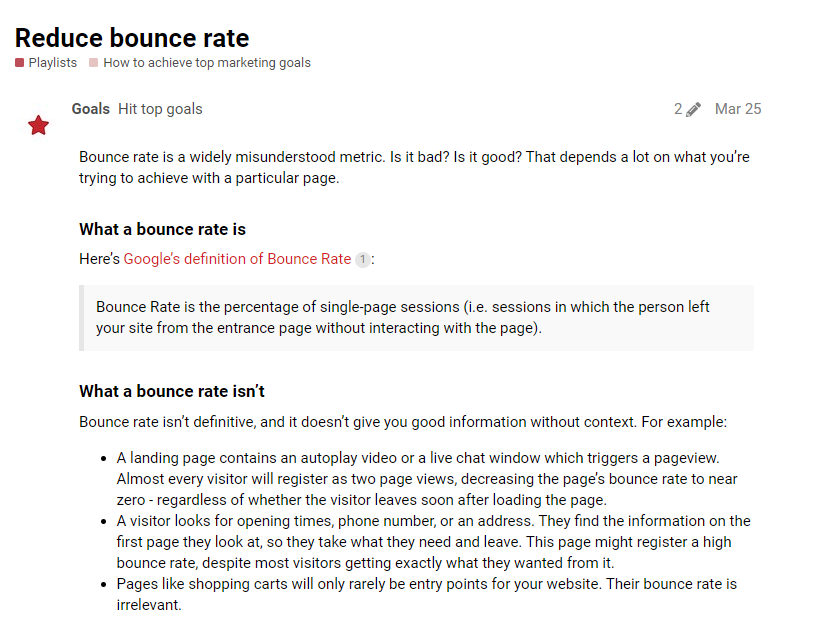
Bounce rate is a potentially confusing term. CXL addresses this at the start of the playbook:
“Bounce rate is a widely misunderstood metric. Is it bad? Is it good? That depends a lot on what you’re trying to achieve with a particular page.”
A definition of what bounce rate is and isn’t follows this statement. By removing confusion, CXL ensures readers interpret bounce rate similarly, leading to consistent execution.
Wherever there’s scope for misinterpretation, eliminate it quickly.
The takeaway: Remember, consistency is the goal here. Be clear and concise, but define and reiterate where needed.
3. For specific tasks, use actionable steps
If you want someone to complete a task efficiently and correctly, give them instructions.
Think of a flat-pack wardrobe. The first time you open the box, you have a ton of pieces and a set of instructions. By the end, you have a completed wardrobe that looks just like the picture.
Could you achieve the same result without instructions? Possibly. But it will take more time and probably induce more stress.
If your playbook is for a certain task, provide readers with clear steps to follow. CXL does this with numbered lists:
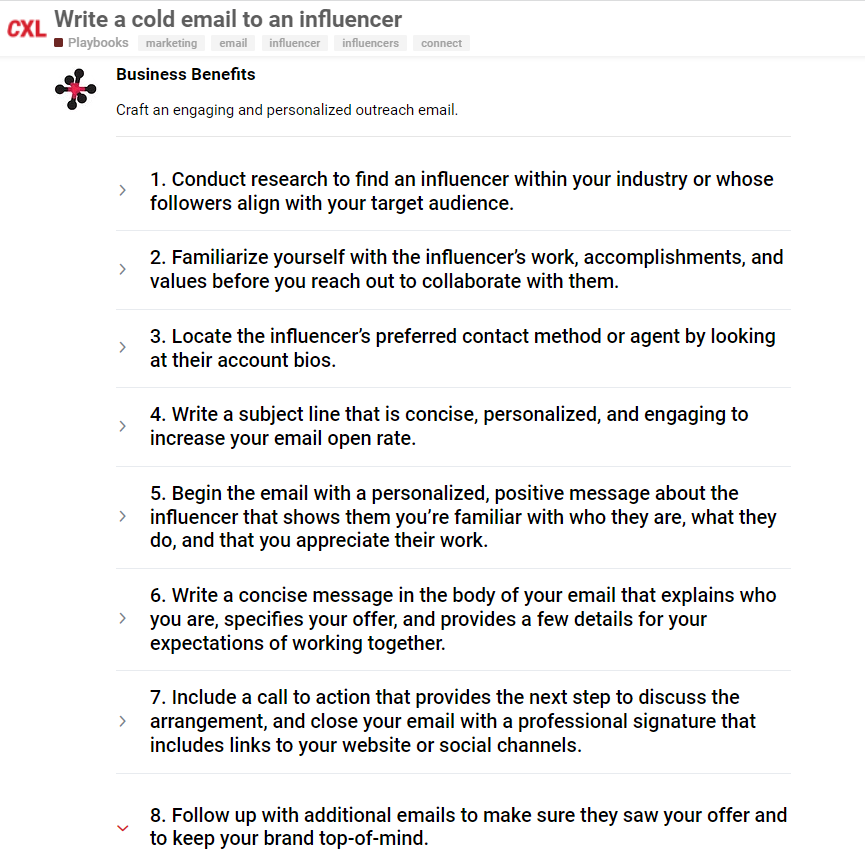
By formatting playbooks this way, readers can easily work their way from start to finish, and every step requires action.
For example, here are the first three steps:
- Conduct research to find an influencer within your industry or whose followers align with your target audience.
- Familiarize yourself with the influencer’s work, accomplishments, and values before you reach out to collaborate with them.
- Locate the influencer’s preferred contact method or agent by looking at their account bios.
Leading steps with an action verb (“conduct,” “familiarize,” “locate”) makes it clear what readers need to do to accomplish the goal.
Tasks are then supported with guidance to help readers do the work:
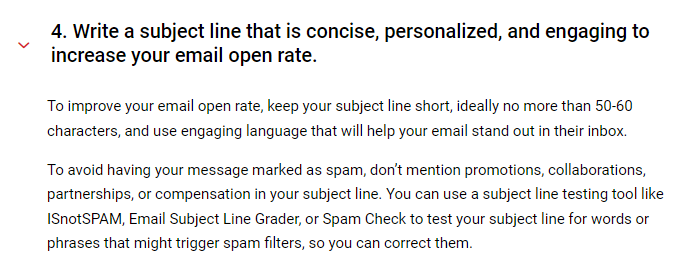
Again, these instructions are actionable. They’re also specific:
“To improve your email open rate, keep your subject line short, ideally no more than 50–60 characters, and use engaging language that will help your email stand out in their inbox.”
Adding “no more than 50–60 characters” removes the subjectivity of “short,” arming readers with rules to follow.
CXL also includes a benefit of following the instruction: “stand out in their inbox.” This gives readers a reason to want to follow the guidance. Do that, and achieve this.
The takeaway: Give readers specific steps.
4. Create a playbook for every goal
Each playbook should only go into so much detail.
For example, if you’re creating a playbook for running a social media marketing campaign, covering each touchpoint would turn a concise document into an encyclopedia.
Consider whether a tactic warrants its own playbook. So, rather than one playbook that goes in-depth on each social media channel, you might create individual playbooks for how to optimize Facebook ads or write killer LinkedIn posts.
CXL’s playbooks are an example of giving readers the information they need without overloading them.
Take this one on increasing customer retention:
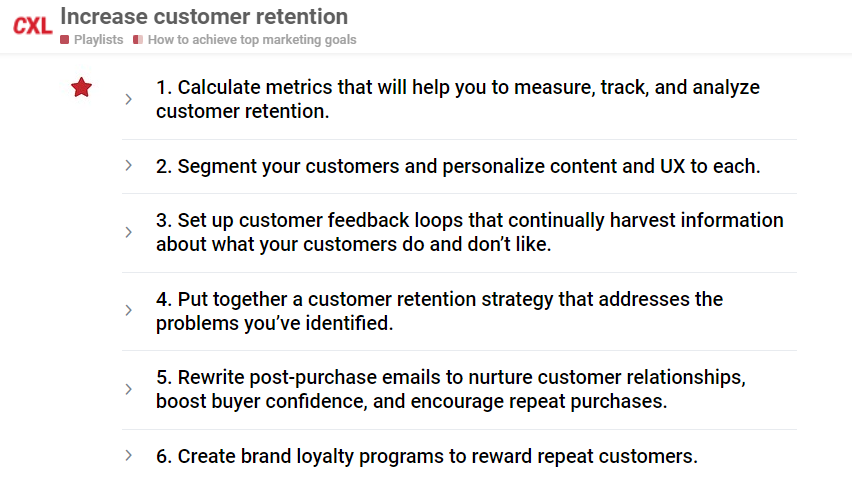
Like previous examples, it uses numbered steps to guide readers to the goal. But let’s look at step one: “Calculate metrics that will help you to measure, track, and analyze customer retention.”
Depending on the reader, we may have two situations: one where the marketer knows exactly which metrics to measure and one where the marketer doesn’t.
The second group of marketers will be wondering what they should measure and how often?
CXL doesn’t attempt to explain within the step. For the first group of marketers, this would be unnecessary information.
Instead, it offers brief instruction, then links to another playbook on how to identify customer retention metrics for users to learn more:
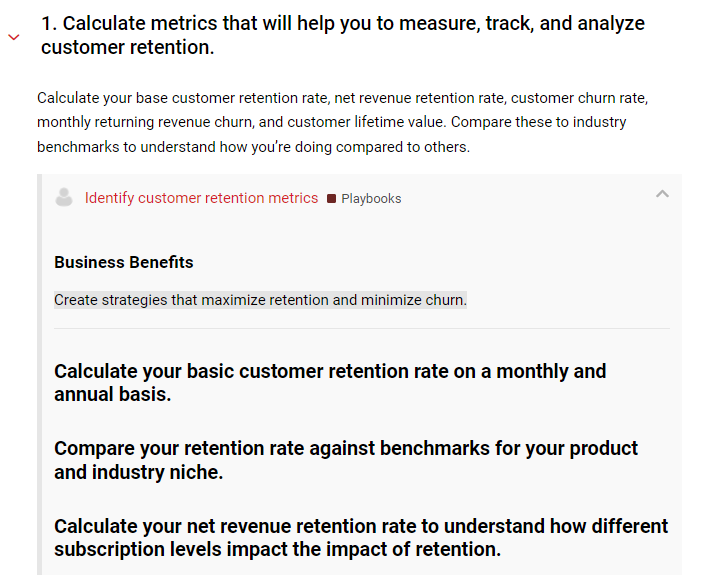
How do you know whether to turn a task into a playbook? If it needs its own set of instructions, it needs more room to breathe.
The takeaway: Consider multiple reader types but don’t try to cater to all in one playbook.
5. Make tasks easy to accomplish
Previous examples have shown how to make playbooks easy to follow with actionable steps. Another way to get users to where they want to be is to take them there.
Much like how playbooks can link to other playbooks, they can also link to tools needed to accomplish a task.
Marketing playbooks tend to cover a lot of ground. It’s more efficient for people to dip in and out of a playbook than read it front to back, then go away and execute.
Linking to tools is another way to improve efficiency. It also eliminates the possibility of people using the wrong tools.
CXL’s playbook for tracking email open rates in Google Analytics, for example, links to the Google Analytics Hit Builder tool:

Its landing page CRO playbook links to SessionCam so that users can quickly get set up recording user sessions:

That puts users in the right place to complete the next steps. Formatting it in bold text grabs attention, helping skim readers quickly find the information they’re looking for.
When designing your playbooks, ask yourself what you can do to reduce stress and eliminate unnecessary steps for team members.
The takeaway: Link to the tools the readers need to streamline workflows.
6. Use examples to increase understanding
If you want to help people learn something new, make it relatable. In its report The Science of Learning, nonprofit organization Deans for Impact looked at the cognitive science behind how people learn.
The report showed that students learn new ideas by relating them to what they already know. To apply this learning to new situations, students must understand the context.
Use examples to leverage this science and communicate the right way of doing things. Examples are also a feature of CXL’s playbooks.
Here’s an instruction from a playbook on setting up A/B tests:

CXL tells readers to “form a hypothesis that is measurable, provides market insights, and solves a conversion problem.”
Seasoned marketers will understand this and can quickly go away and do it. But what about a new junior recruit?
CXL adds clarity with an example: “More people will click through to the landing page (measurable metric) when it shows a family than when it shows a single man (market insight).”
The example might not be specific to the task, but it helps users understand exactly what the instruction means.
In its playbook for increasing customer retention, CXL uses a real-world case study example to help explain customer feedback loops:
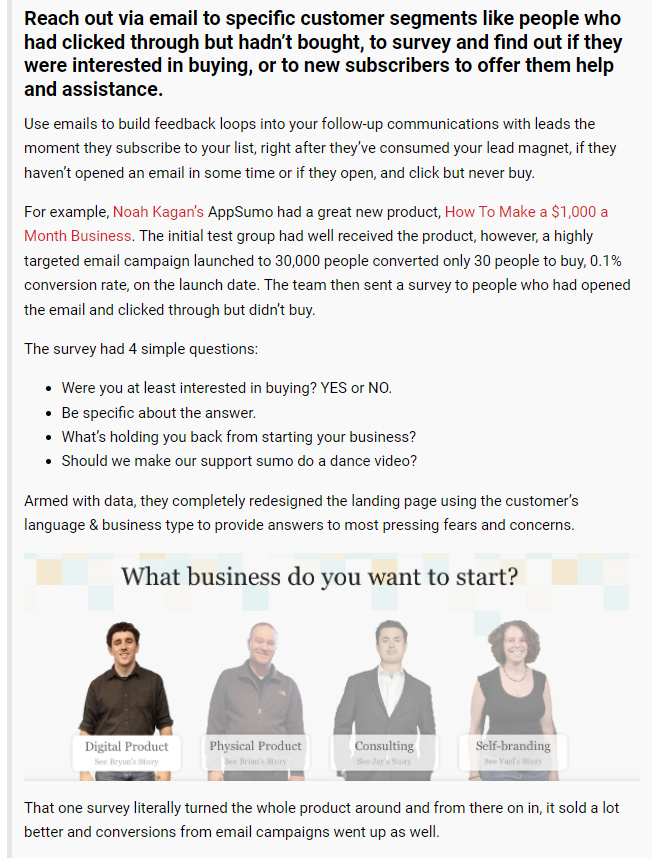
This helps bring context to the task. It also tells users why it matters. Showing how AppSumo improved its conversion rate with feedback loops proves they work, making them more appealing.
At each stage of your playbooks, ask yourself if examples would help users better understand the point. Get feedback from team members at every stage to gauge if the information is clear and easy to understand.
If readers can’t confidently execute their role the first time, add relatable context.
The takeaway: Use examples to improve clarity.
Conclusion
The marketing playbook is both a roadmap and framework. It shows team members how to get from points A to B with consistent results.
Use CXL’s playbooks to inspire your own. Work together as a team to think about the information marketers need to do their job successfully.
Be clear and concise. Elaborate with examples where needed, but avoid unnecessary tangents or instructions that don’t directly influence what you want to achieve. If something needs explaining in-depth, create an additional playbook.
Finally, never leave a playbook on the shelf. Review their impact regularly and update it to stay relevant. Take what you learn from running plays to inform future playbooks and fine-tune your marketing activities.
[ad_2]
Source link









